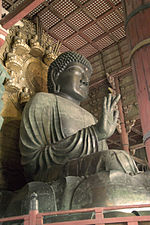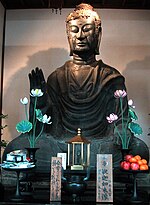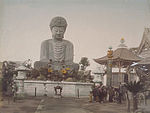Daibutsu
From Wikipedia, the free encyclopedia

Daibutsu in bronze at Kōtoku-in, Kamakura (c.1252); National Treasure; hand-coloured print by Adolfo Farsari
Daibutsu (大仏; kyūjitai 大佛) or 'giant Buddha' is the Japanese term, often used informally, for large statues of Buddha. The oldest is that at Asuka-dera (609) and the best-known those of Tōdai-ji in Nara (752) and Kōtoku-in in Kamakura (c.1252), both National Treasures.[1][2]
Contents |
[edit] Examples
| Image | Name | Buddha | Size | Date | Municipality | Prefecture | Comments |
|---|---|---|---|---|---|---|---|
 |
Shōwa Daibutsu (昭和大仏)[3] | 21.35 metres (70.0 ft) | 1984 | Aomori | Aomori Prefecture | ||
| Ganmen Daibutsu (岩面大仏) | 16.5 metres (54.1 ft) | Hiraizumi | Iwate Prefecture | Low relief carving at Takkoku no Iwa (達谷窟) | |||
 |
Ushiku Daibutsu (牛久大仏)[4] | Amida Nyorai | 120 metres (393.7 ft) including base and lotus (20 metres (65.6 ft)) | 1993 | Ushiku | Ibaraki Prefecture | Japan's largest daibutsu |
 |
Nihon-ji Daibutsu (日本寺大仏)[5] | Yakushi Nyorai | 31.05 metres (101.9 ft) | Edo period | Kyonan | Chiba Prefecture | Carved in the 1780s and 90s by Jingoro Eirei Ono and his apprentices and restored to its present form in 1969. Japan's largest pre-modern (and largest stone-carved) daibutsu. The same site is also home to another large Buddha carving, the Hyakushaku Kannon[citation needed] |
 |
Kamagaya Daibutsu (鎌ヶ谷大仏) | 2.3 metres (7.5 ft), including base (0.5 metres (1.6 ft)) | Kamagaya | Chiba Prefecture | Japan's smallest daibutsu[citation needed] | ||
 |
Former Ueno Daibutsu (上野大仏)[6] | Shaka Nyorai | 1631 | Taitō | Tokyo | Heavily damaged in the 1923 Great Kantō earthquake and melted down for the war effort | |
 |
Tokyo Daibutsu (東京大仏)[7] | 13 metres (42.7 ft) including base | 1977 | Itabashi | Tokyo | Weighs thirty tons; at Jōren-ji (乗蓮寺); erected in expiation of the Great Kantō earthquake and the war | |
 |
Kamakura Daibutsu (鎌倉大仏)[8] | Amida Nyorai | 13.35 metres (43.8 ft) | c.1252 | Kamakura | Kanagawa Prefecture | Subject of the poem The Buddha at Kamakura by Rudyard Kipling; National Treasure |
 |
Takaoka Daibutsu (高岡大仏) | Amida Nyorai | 15.85 metres (52.0 ft) | 1981 | Takaoka | Toyama Prefecture | At Daibutsu-ji (大佛寺) |
| Echizen Daibutsu (越前大仏)[9] | 17 metres (55.8 ft) | Katsuyama | Fukui Prefecture | ||||
| Gifu Daibutsu (岐阜大仏)[10] | Shaka Nyorai | 13.63 metres (44.7 ft) | 1828 | Gifu | Gifu Prefecture | ||
 |
Former Hōkō-ji Daibutsu | 1660s | Kyoto | Kyoto Prefecture | Sketch of c.1691 by Engelbert Kaempfer | ||
 |
Nara Daibutsu (奈良大仏)[11] | Vairocana | 14.98 metres (49.1 ft) | 752 | Nara | Nara Prefecture | Restored several times; part of the UNESCO World Heritage Site: Historic Monuments of Ancient Nara; National Treasure |
 |
Asuka Daibutsu (飛鳥大仏)[2][12] | Shaka Nyorai | 2.75 metres (9.0 ft) | 609 | Asuka | Nara Prefecture | Japan's oldest daibutsu and Buddhist statue, restored; Important Cultural Property |
 |
Former Hyōgo Daibutsu (兵庫大仏)[13] | 1891 | Kobe | Hyōgo Prefecture | At Nōfuku-ji (能福寺); melted down in 1944 for the war effort[citation needed] and since replaced |
[edit] See also
| Wikimedia Commons has media related to: Category:Buddha statues in Japan |
[edit] References
- ^ "Daibutsu". Japanese Architecture and Art Net Users System. http://www.aisf.or.jp/~jaanus/deta/d/daibutsu.htm. Retrieved 23 May 2011.
- ^ a b "Sandaibutsu". Japanese Architecture and Art Net Users System. http://www.aisf.or.jp/~jaanus/deta/s/sandaibutsu.htm. Retrieved 23 May 2011.
- ^ "Shōwa Daibutsu". Seiryū-ji. http://www.showa-daibutu.com/. Retrieved 23 May 2011.
- ^ "Ushiku Daibutsu". Ushiku Daibutsu. http://www.ushikukankou.com/ushikudaibutsu_sugao.htm. Retrieved 23 May 2011.
- ^ "Nihonji Daibutsu". Nihon-ji. http://www.nihonji.jp/revival/index.html. Retrieved 23 May 2011.
- ^ "Ueno Daibutsu". Daily Yomiuri. 30 March 2010. http://www.yomiuri.co.jp/e-japan/siseki/20100413-OYT8T00589.htm. Retrieved 23 May 2011.
- ^ "Tokyo Daibutsu". Itabashi Ward. http://www.city.itabashi.tokyo.jp/c_kurashi/003/003913.html. Retrieved 23 May 2011.
- ^ "Database of National Cultural Properties". Agency for Cultural Affairs. http://www.bunka.go.jp/bsys/maindetails.asp?register_id=201&item_id=270. Retrieved 23 May 2011.
- ^ Katsuyama History "Katsuyama Profile". Katsuyama City. http://www.city.katsuyama.fukui.jp/english/english.html Katsuyama History. Retrieved 4 December 2007.
- ^ Gifu Shouhouji Daibutsu "Gifu Shouhouji Daibutsu (Great Buddha)". Shōhō-ji. http://www.gifu-daibutsu.com/shohoji/english.html Gifu Shouhouji Daibutsu. Retrieved 4 December 2007.
- ^ "Database of National Cultural Properties". Agency for Cultural Affairs. http://www.bunka.go.jp/bsys/maindetails.asp?register_id=201&item_id=271. Retrieved 23 May 2011.
- ^ "Database of National Cultural Properties". Agency for Cultural Affairs. http://www.bunka.go.jp/bsys/maindetails.asp?register_id=201&item_id=4256. Retrieved 23 May 2011.
- ^ "Daibutsu Hyogo". Nagasaki University Library. http://oldphoto.lb.nagasaki-u.ac.jp/en/target.php?id=1044. Retrieved 23 May 2011.
[edit] External links
- Photographs and information on famous Daibutsu
- New York Public Library Digital Gallery, early photograph of Kamakura Daibutsu from rear
- New York Public Library Digital Gallery, early photograph of Hyōgo Daibutsu
|
|||||||